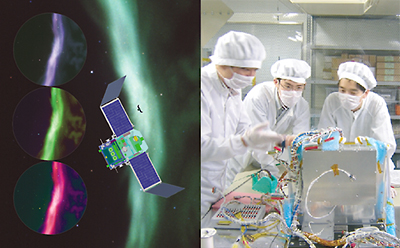TOP > Report & Column > The Forefront of Space Science > 2004 > Development of Small Highly Functional Science Satellite, INDEX
![]()

Scientific satellites developed by the Institute of Space and Astronautical Science (ISAS) of JAXA are becoming larger in scale, requiring between 7 to 12 years lead-time in development and costing about 12 billion yen to develop and 6 billion yen to launch. In addition, due to recent budgetary restrictions, we are now in a situation where it is difficult to launch one satellite per year as in the past. From the viewpoint of space science, this means a loss of opportunities to conduct small-scale science missions which are not covered by large-scale missions, raising the potential warning that sound space-science activities will not be maintained. Addressing this problem in ISAS, a new idea was proposed to develop and launch relatively low-cost, small satellites of about 100 to 500kg. Meanwhile, from the aspect of satellite technology, satellite missions requiring a 10-year development span prolong the technical innovation cycle. There is also the potential problem of a conservative approach to the introduction of new satellite technologies, in order to ensure reliability with expensive satellites. On the other hand, when the pursuit of low-cost satellites alone is emphasized, a similar problem arises toward new technologies since cost factors become dominant. The effective approach in this situation is to develop and launch in a timely manner small-to-medium-size satellites which employ bold new technologies. One approach, the piggyback satellite INDEX (INnovative-technology Demonstration Experiment) is under development at FM (flight model) test phase as of July 2004. The target of INDEX is to develop a small science satellite by boldly incorporating new technologies, instead of developing a low-cost standard bus (set of instruments necessary for basic satellite operation) satellite.
Advanced small satellite developed in-house The INDEX project aims to implement excellent small-scale space-science observations along with its engineering purpose: the demonstration of the most advanced satellite technologies in orbit. The project calls for developing a 50 to 70kg-class small satellite in about three years and launching it as a piggyback satellite on H-IIA or the equivalent to realize a low-cost launch. (A piggyback satellite is a small satellite launched together with the main satellite, using the launcher’s surplus payload capacity.) The following policies have been set up for INDEX satellite development.
The development scheme adopting in-house policy is clearly indicated in Table 1, which describes responsibility for each satellite system. Most advanced satellite instruments mentioned in (3) above were developed in the STRAIGHT (STudy on the Reduction of Advanced Instrument weight) program promoted by the authors and others at ISAS.
In ISAS, two groups responsible for performing science missions and developing satellite technologies are working in close cooperation. Our approach is to develop high-performance onboard instruments necessary for future satellite plans prior to full-scale satellite development. This is called the STRAIGHT program. In the program, considering the characteristics of future-satellite plans, we have studied the necessary instruments and performance, and spent time developing such instruments even with a developmental risk. Development covers almost all the satellite subsystems including: optical attitude sensor; processor; devices for space application; battery; thermal control element; honeycomb panel; and GPS receiver. The result of these efforts at satellite-technology development with an eye on the future supports INDEX, a small, high-performance scientific satellite. INDEX is a good mission for the STRAIGHT program, because we can reduce the risks of using newly developed instruments immediately in large-scale scientific satellites.
|
|||||||||||||||||||







